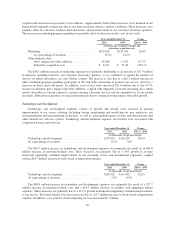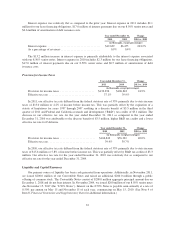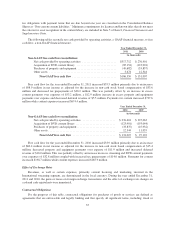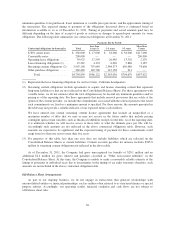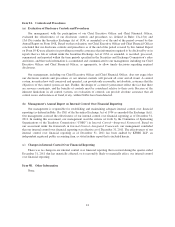NetFlix 2011 Annual Report Download - page 40
Download and view the complete annual report
Please find page 40 of the 2011 NetFlix annual report below. You can navigate through the pages in the report by either clicking on the pages listed below, or by using the keyword search tool below to find specific information within the annual report.recognition in the content library because the underlying license agreement does not specify the number of titles
or the license fee per title or the windows of availability per title, so that the license fee is not known or
reasonably determinable for a specific title. Typical payment terms for these agreements, which can range from
three to five years, require us to make equal fixed payments at the beginning of each quarter of the license term.
To the extent that cumulative payments exceed cumulative amortization, “Prepaid content” is recorded on the
Consolidated Balance Sheets. We amortize the license fees on a straight-line basis over the term of each license
agreement. The amortization is classified in “Cost of revenues- Subscription” in the Consolidated Statements of
Operations and in the line item “Net income” within net cash provided by operating activities in the Consolidated
Statements of Cash Flows. Changes in prepaid content are classified within net cash provided by operating
activities in the line item “Prepaid content” in the Consolidated Statements of Cash Flows. Commitments for
licenses that do not meet the criteria for asset recognition in the content library are included in Note 5 of Item 8,
Financial Statements and Supplementary Data.
We acquire DVD content for the purpose of renting such content to our subscribers and earning subscription
rental revenues, and, as such, we consider our direct purchase DVD library to be a productive asset. Accordingly,
we classify our DVD library in “Non-current content library” on the Consolidated Balance Sheets. The
acquisition of DVD content library, net of changes in related liabilities, is classified in the line item “Acquisition
of DVD content library” within cash used in investing activities in the Consolidated Statements of Cash Flows
because the DVD content library is considered a productive asset. Other companies in the in-home entertainment
video industry classify these cash flows as operating activities. We amortize our direct purchase DVDs, less
estimated salvage value, on a “sum-of-the-months” accelerated basis over their estimated useful lives. The useful
life of the new release DVDs and back-catalog DVDs is estimated to be one year and three years, respectively.
The amortization of the DVD content library is classified in “Cost of revenues—Subscription” in the
Consolidated Statement of Operations and in the line item “Amortization of DVD content library” within net
cash provided by operating activities in the Consolidated Statements of Cash Flows. We also obtain DVD content
through revenue sharing agreements with studios and distributors. Revenue sharing obligations incurred based on
utilization are classified in “Cost of revenues—Subscription” in the Consolidated Statements of Operations and
in the line item “Net income” within net cash provided by operating activities in the Consolidated Statements of
Cash Flows. The terms of some revenue sharing agreements obligate us to make a low initial payment for certain
titles, representing a minimum contractual obligation under the agreement. The low initial payment is in
exchange for a commitment to share a percentage of our subscription revenues or to pay a fee, based on
utilization, for a defined period of time. The initial payment may be in the form of an upfront non-refundable
payment which is classified in content library or in the form of a prepayment of future revenue sharing
obligations which is classified as prepaid content.
Stock-Based Compensation
Stock-based compensation expense at the grant date is based on the total number of options granted and an
estimate of the fair value of the awards expected to vest and is recognized as expense ratably over the requisite
service period, which is the vesting period.
We calculate the fair value of new stock-based compensation awards under our stock option plans using a
lattice-binomial model. We use a Black-Scholes model to determine the fair value of employee stock purchase
plan shares. These models require the input of highly subjective assumptions, including price volatility of the
underlying stock. Changes in the subjective input assumptions can materially affect the estimate of fair value of
options granted and our results of operations could be impacted.
•Expected Volatility: Our computation of expected volatility is based on a blend of historical volatility of
our common stock and implied volatility of tradable forward call options to purchase shares of our
common stock. Our decision to incorporate implied volatility was based on our assessment that implied
volatility of publicly traded options in our common stock is more reflective of market conditions and,
38




